by Jason Bodner
April 23, 2024
Weeks ago, an earthquake hit the New York City area. It prompted some shock waves, but shouldn’t have done so … the U.S. Geological Survey estimates that 500,000 earthquakes happen every year. Many are deep within the Earth’s crust and go undetected without seismographs. Humans can feel only 20% of the world’s earthquakes. Only around 100 per year cause any significant damage.
When the news of the New York quake hit, the stock market responded with a nice rally! The real market quake hit a day earlier, when a hotter-than-expected jobs report came out. That meant a delay in rate cuts. The economic aftershocks have been fairly severe. The S&P 500 ETF (SPY) has fallen ever since then:
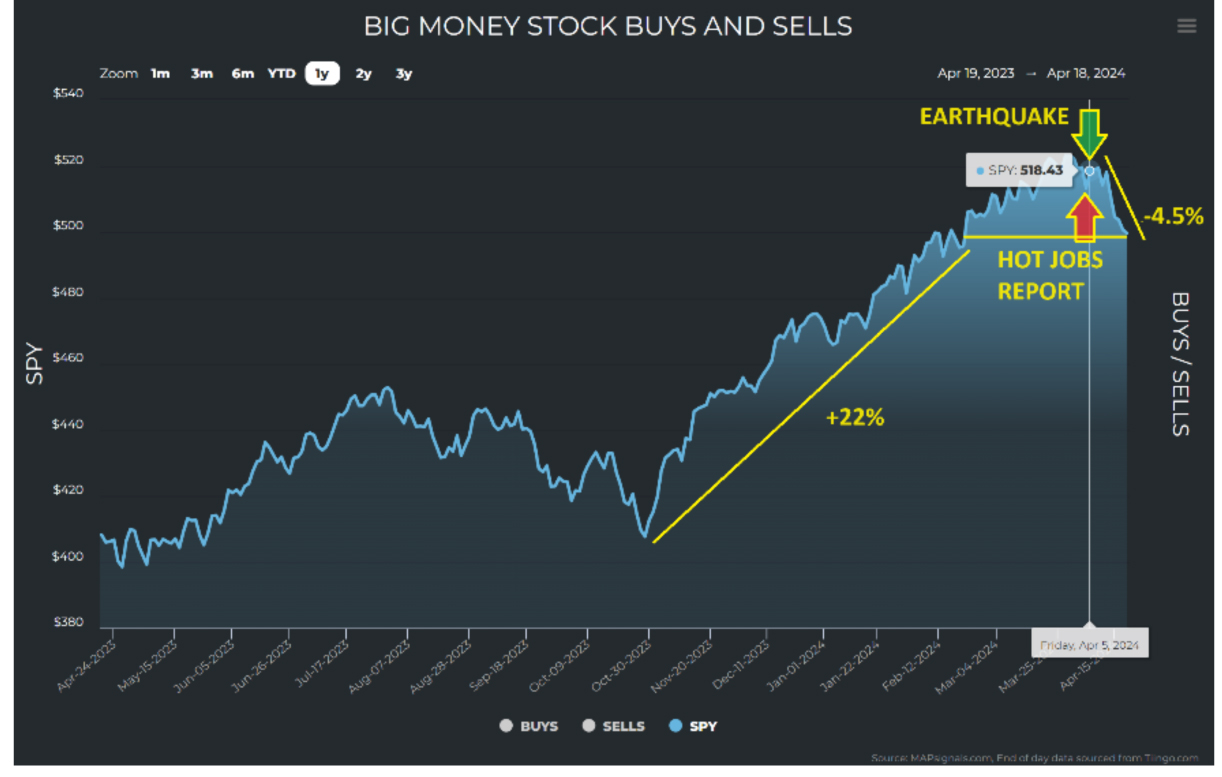
Graphs are for illustrative and discussion purposes only. Please read important disclosures at the end of this commentary.
The market feels bad, but to put things in context, we simply returned to levels last seen around February 21st, which is still up 22% from October 2023. So maybe we shouldn’t fret over a much-needed pullback.
Or should we? A week ago, I would have said “don’t worry.” Now, I’m not so sure, at least for the near-term. Longer term, and for the rest of the year and beyond, I am still bullish. But the recent backdrop over renewed rate-cut anxiety has tipped some scales… and not for the good of a sustained rally.
Let’s dig into some things we need to know… First, the Big Money Index (BMI) cut sharply through its support, which started in early February. For a long while, it traded in a tight range between 70 and 74 — until April 11th, that is, when it broke below 70, and it’s been falling hard (to near 50) ever since then.
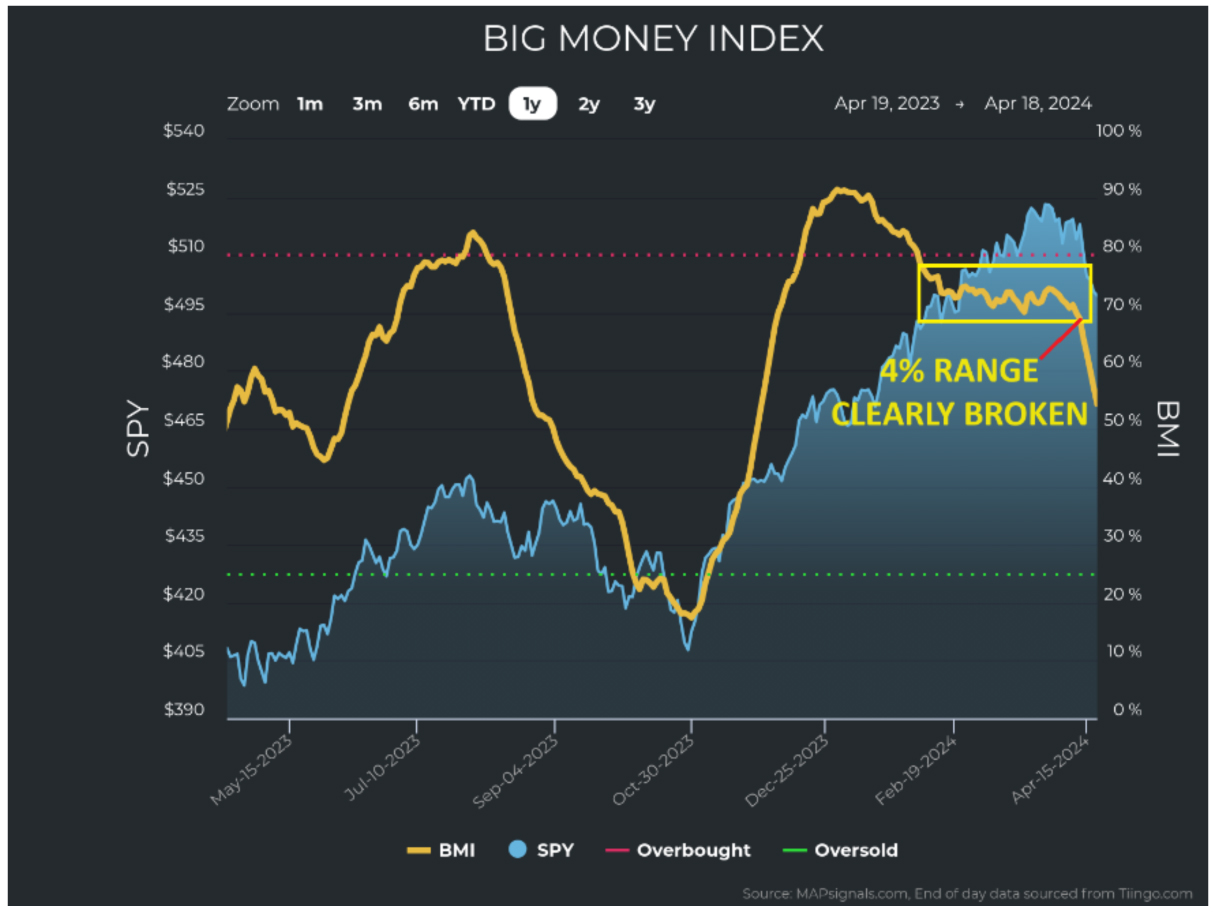
Graphs are for illustrative and discussion purposes only. Please read important disclosures at the end of this commentary.
I have been saying for weeks that the important thing is when the BMI falls from overbought. It did that in December, but the market kept rising. The BMI was falling due to a drop-off in buying, not an increase in selling, but things have changed in the last week, and quickly. The risk takers clearly had a change of heart since the last jobs report and CPI came out. For the first time in a long time, unusual selling has picked up. In fact, we are seeing the highest selling since the October lows in both stocks and ETFs:
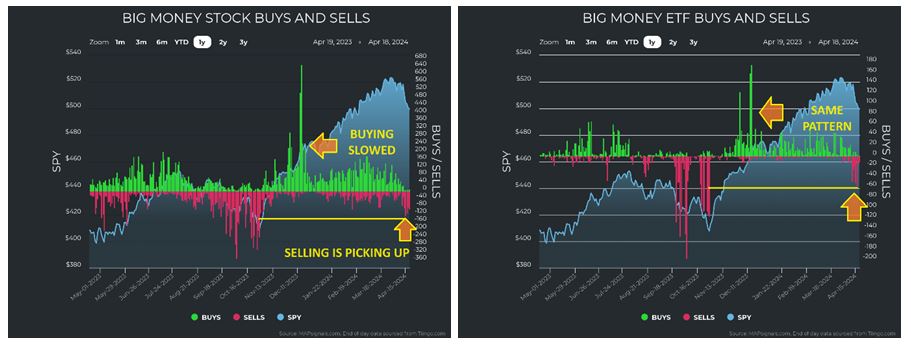
Graphs are for illustrative and discussion purposes only. Please read important disclosures at the end of this commentary.
This becomes perfectly clear when we look at last week’s distribution of selling versus buying. On the left you will see last week’s unusual buy and sell signals for stocks. The first thing we notice is that, excluding Friday, there were 411 sell signals over four days. For context, it took 13 trading days, or nearly three weeks, to accumulate that many sell signals prior to last Monday, Tax Day, April 15.
Looking at it another way, the daily average of sell signals for April 15-18 was 105. In contrast, the daily average since November 1st was 27. The chart on the right shows how starkly last week’s signals differ:
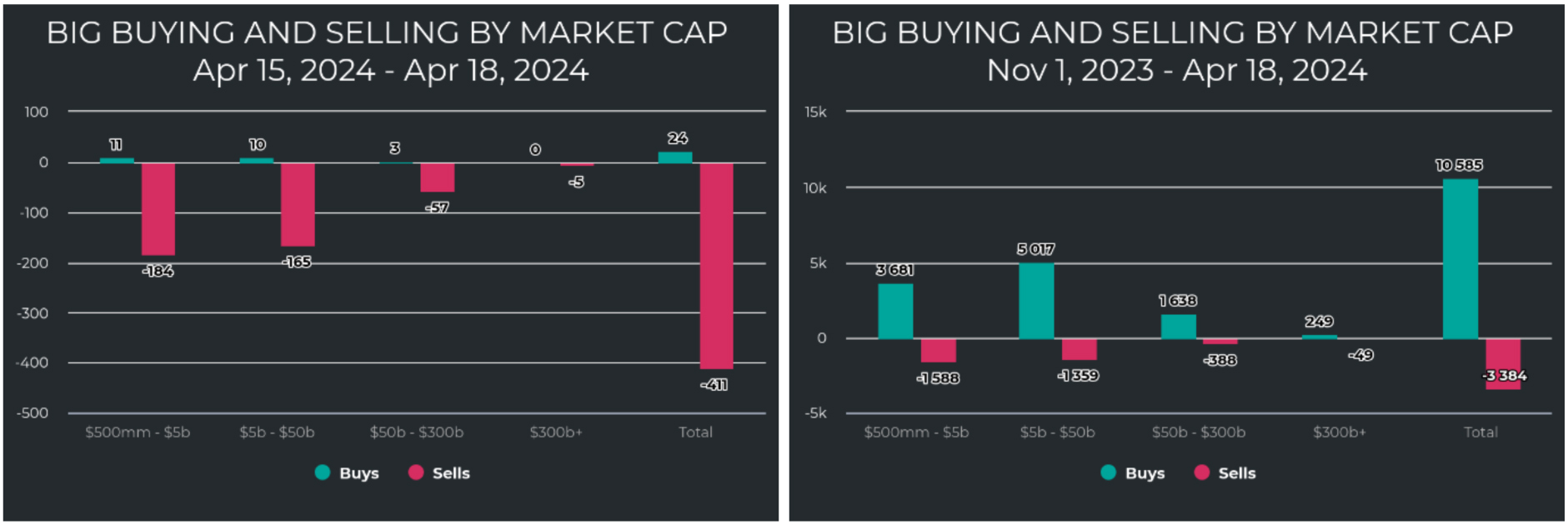
Graphs are for illustrative and discussion purposes only. Please read important disclosures at the end of this commentary.
I have also been praising the market’s underlying resilience. What I mean is that the individual sectors have been strong despite a sagging BMI. But last week, the tenor changed visibly. Not only are we seeing all sector charts breaking down, but we are also seeing signs of selling. Many sectors had virtually no selling to speak of since November. Now, the picture is changing:

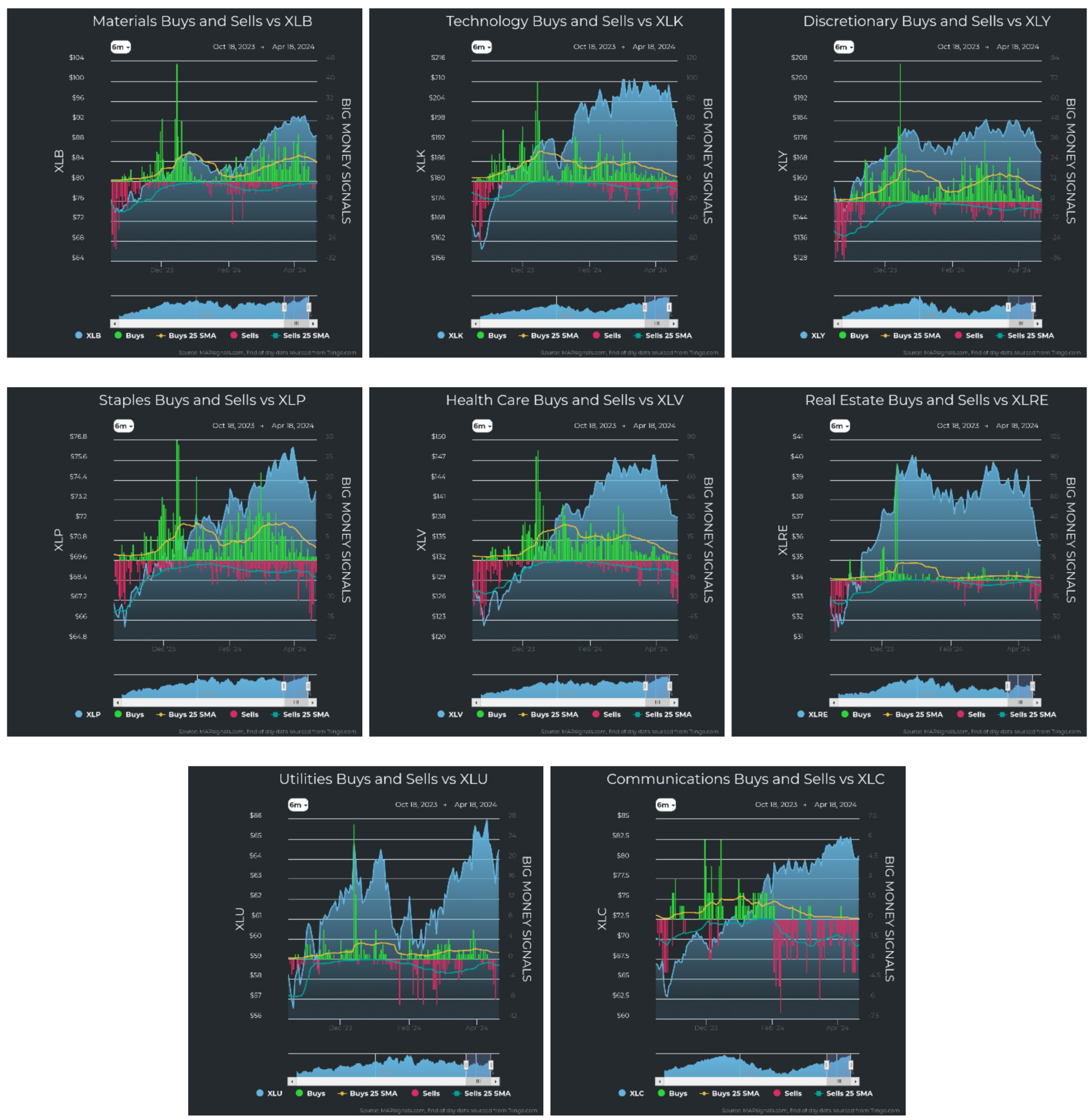
Graphs are for illustrative and discussion purposes only. Please read important disclosures at the end of this commentary.
This is also affecting the sector strength and weakness table. Technology was making a comeback, but suddenly it slipped back down to number 5 on the list:
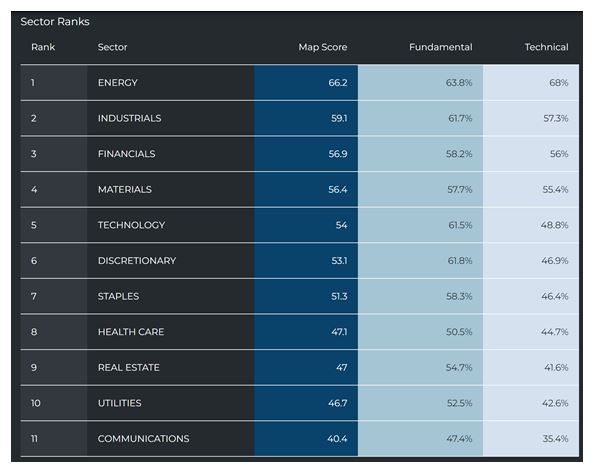
Graphs are for illustrative and discussion purposes only. Please read important disclosures at the end of this commentary.
We are seeing some other signs of fear and caution. Interest rates have spiked. The 10-year rate poked above highs not seen since November:
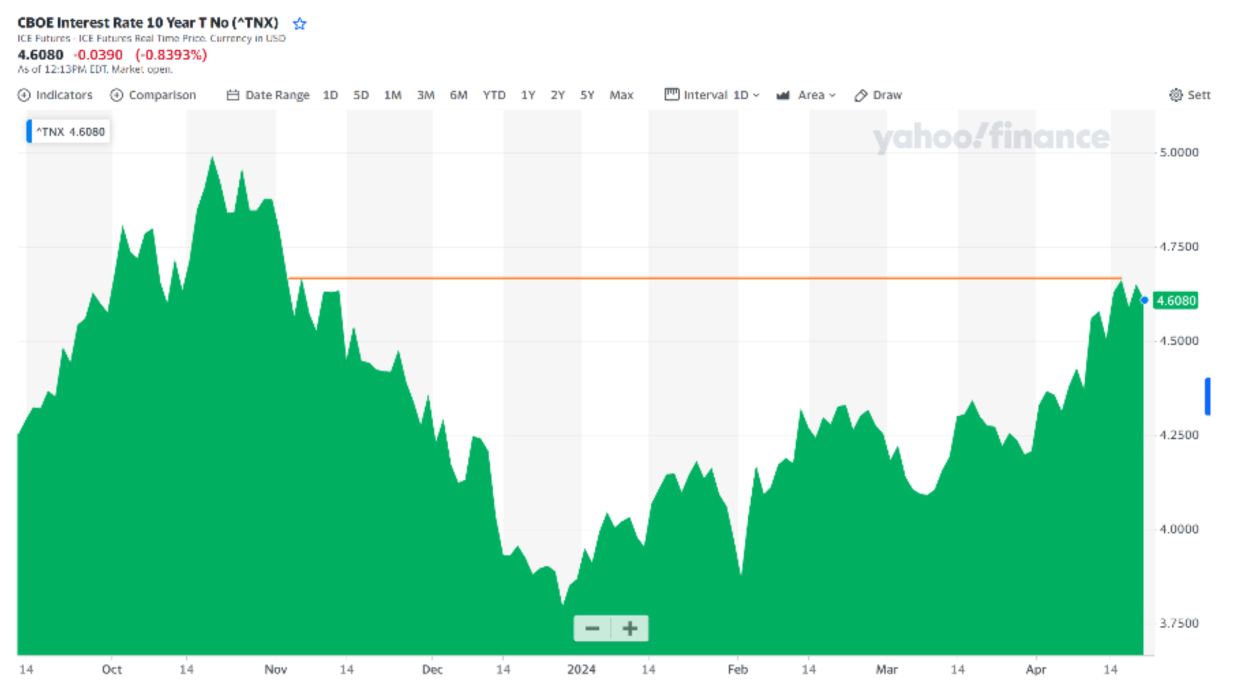
Graphs are for illustrative and discussion purposes only. Please read important disclosures at the end of this commentary.
Middle East tensions are flaring. Wars are raging. The political landscape is heating up. We have an election coming soon. It feels like things are bubbling to the brim and it’s hard to find a glimmer of hope. It’s hard to remember that we are still only a few percentage points from the all-time highs for stocks.
So, I’ve laid out a pretty compelling case for the bears. But should we worry about all this stuff?
The short answer is … maybe, but ultimately not. Global issues will always dominate the headlines as long as we are fallible human beings. Stocks, however, seem to keep rising… at least for the last 100 years, so before we get our bear suits on, I want to offer some context for why we shouldn’t freak out.
In fact, the data still says the opposite. If history repeats itself, there is a big opportunity on the horizon.
Something new and interesting happened in the last week. Both the BMI and the SPY (S&P 500 ETF) fell for five consecutive days in tandem. It may seem like that would happen fairly often, but in fact, the opposite is true. MAPsignals has data going back to January 1st, 1990. That is nearly 34.5 years, or 8,614 trading days. I searched for all the times where both the SPY and BMI fell together for 5 straight days or more. There were only 39 instances when that happened or 0.5% of the time (and many dates overlap).
In other words, 99.5% of the time we don’t see five straight down days in both the BMI and the SPY.
So, what happens after these ultra-rare convergences? Well, I’m glad you asked! Below, the table shows each date as well as the successive returns of the SPY 1, 3, 6, 9, 12, and 24 months later. The results are nothing short of awesome. They were also higher a stunning 80% of the time on average:

Graphs are for illustrative and discussion purposes only. Please read important disclosures at the end of this commentary.
Here is the full table:
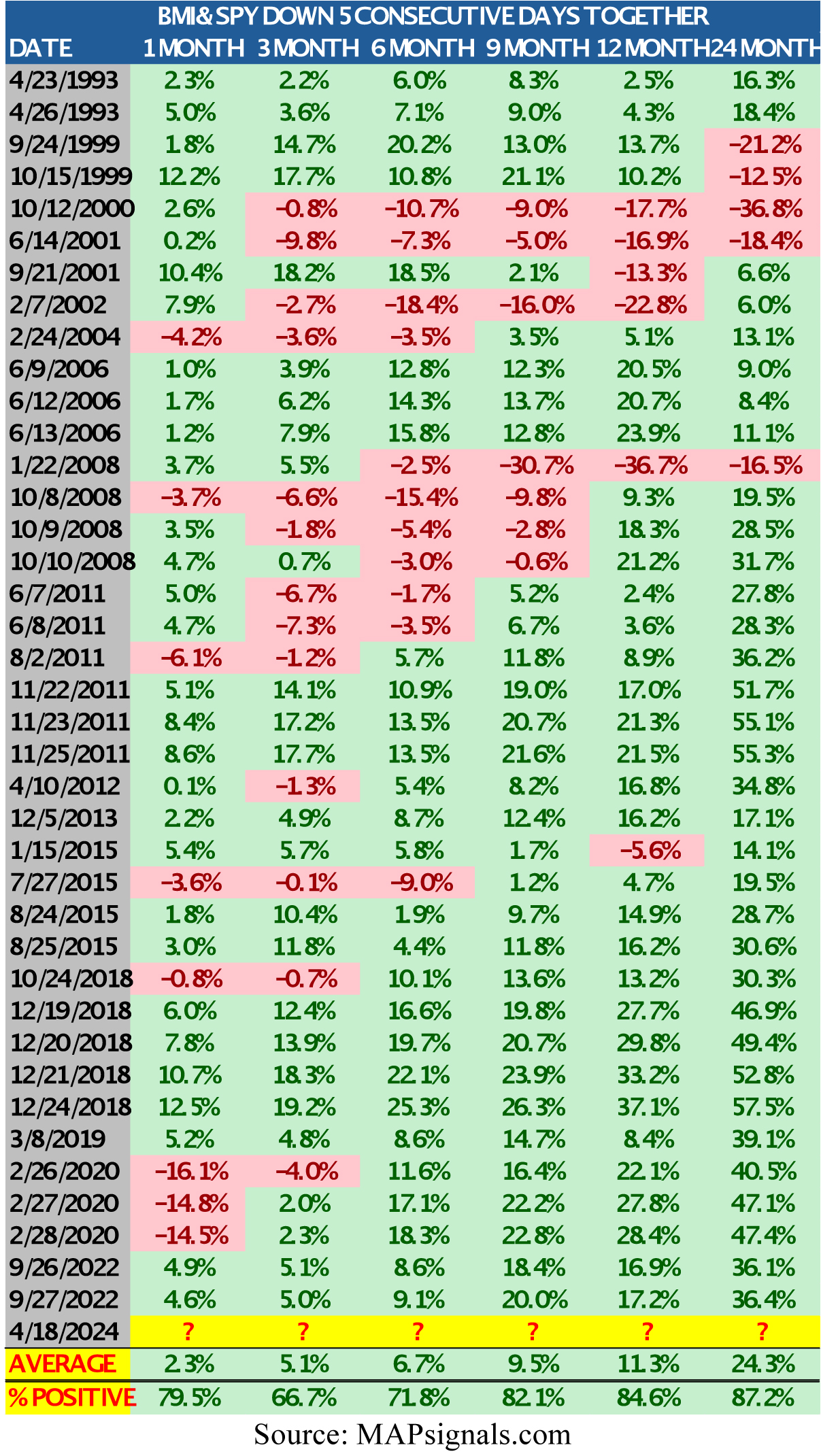
Graphs are for illustrative and discussion purposes only. Please read important disclosures at the end of this commentary.
So, the data tells us we should not freak out. We need to ride through some volatility that we have long said is overdue. More importantly, we should be eyeballing quality stocks that may go on forced sale.
Capitulation may be near, or it may take a while to play out. But in any case, this super-rare signal says we should start to get greedy when others are fearful. Remember, fear will always be part of the game.
Or, in the words of George Adair: “Everything you’ve ever wanted is on the other side of fear.”
All content above represents the opinion of Jason Bodner of Navellier & Associates, Inc.
Also In This Issue
A Look Ahead by Louis Navellier
Mixed Earnings Reports Send Stocks Spinning
Income Mail by Bryan Perry
Will Earnings Season Be a Salve to a Wounded Market?
Growth Mail by Gary Alexander
Time for Some Spring (Tech Stock?) House Cleaning?
Global Mail by Ivan Martchev
It Looks Like Some Middle East Missiles are Pure Theater
Sector Spotlight by Jason Bodner
The Big Money Index Finally Sees Some Selling
View Full Archive
Read Past Issues Here

Jason Bodner
MARKETMAIL EDITOR FOR SECTOR SPOTLIGHT
Jason Bodner writes Sector Spotlight in the weekly Marketmail publication and has authored several white papers for the company. He is also Co-Founder of Macro Analytics for Professionals which produces proprietary equity accumulation/distribution research for its clients. Previously, Mr. Bodner served as Director of European Equity Derivatives for Cantor Fitzgerald Europe in London, then moved to the role of Head of Equity Derivatives North America for the same company in New York. He also served as S.V.P. Equity Derivatives for Jefferies, LLC. He received a B.S. in business administration in 1996, with honors, from Skidmore College as a member of the Periclean Honors Society. All content of “Sector Spotlight” represents the opinion of Jason Bodner
Important Disclosures:
Jason Bodner is a co-founder and co-owner of Mapsignals. Mr. Bodner is an independent contractor who is occasionally hired by Navellier & Associates to write an article and or provide opinions for possible use in articles that appear in Navellier & Associates weekly Market Mail. Mr. Bodner is not employed or affiliated with Louis Navellier, Navellier & Associates, Inc., or any other Navellier owned entity. The opinions and statements made here are those of Mr. Bodner and not necessarily those of any other persons or entities. This is not an endorsement, or solicitation or testimonial or investment advice regarding the BMI Index or any statements or recommendations or analysis in the article or the BMI Index or Mapsignals or its products or strategies.
Although information in these reports has been obtained from and is based upon sources that Navellier believes to be reliable, Navellier does not guarantee its accuracy and it may be incomplete or condensed. All opinions and estimates constitute Navellier’s judgment as of the date the report was created and are subject to change without notice. These reports are for informational purposes only and are not a solicitation for the purchase or sale of a security. Any decision to purchase securities mentioned in these reports must take into account existing public information on such securities or any registered prospectus.To the extent permitted by law, neither Navellier & Associates, Inc., nor any of its affiliates, agents, or service providers assumes any liability or responsibility nor owes any duty of care for any consequences of any person acting or refraining to act in reliance on the information contained in this communication or for any decision based on it.
Past performance is no indication of future results. Investment in securities involves significant risk and has the potential for partial or complete loss of funds invested. It should not be assumed that any securities recommendations made by Navellier. in the future will be profitable or equal the performance of securities made in this report. Dividend payments are not guaranteed. The amount of a dividend payment, if any, can vary over time and issuers may reduce dividends paid on securities in the event of a recession or adverse event affecting a specific industry or issuer.
None of the stock information, data, and company information presented herein constitutes a recommendation by Navellier or a solicitation to buy or sell any securities. Any specific securities identified and described do not represent all of the securities purchased, sold, or recommended for advisory clients. The holdings identified do not represent all of the securities purchased, sold, or recommended for advisory clients and the reader should not assume that investments in the securities identified and discussed were or will be profitable.
Information presented is general information that does not take into account your individual circumstances, financial situation, or needs, nor does it present a personalized recommendation to you. Individual stocks presented may not be suitable for every investor. Investment in securities involves significant risk and has the potential for partial or complete loss of funds invested. Investment in fixed income securities has the potential for the investment return and principal value of an investment to fluctuate so that an investor’s holdings, when redeemed, may be worth less than their original cost.
One cannot invest directly in an index. Index is unmanaged and index performance does not reflect deduction of fees, expenses, or taxes. Presentation of Index data does not reflect a belief by Navellier that any stock index constitutes an investment alternative to any Navellier equity strategy or is necessarily comparable to such strategies. Among the most important differences between the Indices and Navellier strategies are that the Navellier equity strategies may (1) incur material management fees, (2) concentrate its investments in relatively few stocks, industries, or sectors, (3) have significantly greater trading activity and related costs, and (4) be significantly more or less volatile than the Indices.
ETF Risk: We may invest in exchange traded funds (“ETFs”) and some of our investment strategies are generally fully invested in ETFs. Like traditional mutual funds, ETFs charge asset-based fees, but they generally do not charge initial sales charges or redemption fees and investors typically pay only customary brokerage fees to buy and sell ETF shares. The fees and costs charged by ETFs held in client accounts will not be deducted from the compensation the client pays Navellier. ETF prices can fluctuate up or down, and a client account could lose money investing in an ETF if the prices of the securities owned by the ETF go down. ETFs are subject to additional risks:
- ETF shares may trade above or below their net asset value;
- An active trading market for an ETF’s shares may not develop or be maintained;
- The value of an ETF may be more volatile than the underlying portfolio of securities the ETF is designed to track;
- The cost of owning shares of the ETF may exceed those a client would incur by directly investing in the underlying securities; and
- Trading of an ETF’s shares may be halted if the listing exchange’s officials deem it appropriate, the shares are delisted from the exchange, or the activation of market-wide “circuit breakers” (which are tied to large decreases in stock prices) halts stock trading generally.
Grader Disclosures: Investment in equity strategies involves substantial risk and has the potential for partial or complete loss of funds invested. The sample portfolio and any accompanying charts are for informational purposes only and are not to be construed as a solicitation to buy or sell any financial instrument and should not be relied upon as the sole factor in an investment making decision. As a matter of normal and important disclosures to you, as a potential investor, please consider the following: The performance presented is not based on any actual securities trading, portfolio, or accounts, and the reported performance of the A, B, C, D, and F portfolios (collectively the “model portfolios”) should be considered mere “paper” or pro forma performance results based on Navellier’s research.
Investors evaluating any of Navellier & Associates, Inc.’s, (or its affiliates’) Investment Products must not use any information presented here, including the performance figures of the model portfolios, in their evaluation of any Navellier Investment Products. Navellier Investment Products include the firm’s mutual funds and managed accounts. The model portfolios, charts, and other information presented do not represent actual funded trades and are not actual funded portfolios. There are material differences between Navellier Investment Products’ portfolios and the model portfolios, research, and performance figures presented here. The model portfolios and the research results (1) may contain stocks or ETFs that are illiquid and difficult to trade; (2) may contain stock or ETF holdings materially different from actual funded Navellier Investment Product portfolios; (3) include the reinvestment of all dividends and other earnings, estimated trading costs, commissions, or management fees; and, (4) may not reflect prices obtained in an actual funded Navellier Investment Product portfolio. For these and other reasons, the reported performances of model portfolios do not reflect the performance results of Navellier’s actually funded and traded Investment Products. In most cases, Navellier’s Investment Products have materially lower performance results than the performances of the model portfolios presented.
This report contains statements that are, or may be considered to be, forward-looking statements. All statements that are not historical facts, including statements about our beliefs or expectations, are “forward-looking statements” within the meaning of The U.S. Private Securities Litigation Reform Act of 1995. These statements may be identified by such forward-looking terminology as “expect,” “estimate,” “plan,” “intend,” “believe,” “anticipate,” “may,” “will,” “should,” “could,” “continue,” “project,” or similar statements or variations of such terms. Our forward-looking statements are based on a series of expectations, assumptions, and projections, are not guarantees of future results or performance, and involve substantial risks and uncertainty as described in Form ADV Part 2A of our filing with the Securities and Exchange Commission (SEC), which is available at www.adviserinfo.sec.gov or by requesting a copy by emailing info@navellier.com. All of our forward-looking statements are as of the date of this report only. We can give no assurance that such expectations or forward-looking statements will prove to be correct. Actual results may differ materially. You are urged to carefully consider all such factors.
FEDERAL TAX ADVICE DISCLAIMER: As required by U.S. Treasury Regulations, you are informed that, to the extent this presentation includes any federal tax advice, the presentation is not written by Navellier to be used, and cannot be used, for the purpose of avoiding federal tax penalties. Navellier does not advise on any income tax requirements or issues. Use of any information presented by Navellier is for general information only and does not represent tax advice either express or implied. You are encouraged to seek professional tax advice for income tax questions and assistance.
IMPORTANT NEWSLETTER DISCLOSURE:The hypothetical performance results for investment newsletters that are authored or edited by Louis Navellier, including Louis Navellier’s Growth Investor, Louis Navellier’s Breakthrough Stocks, Louis Navellier’s Accelerated Profits, and Louis Navellier’s Platinum Club, are not based on any actual securities trading, portfolio, or accounts, and the newsletters’ reported hypothetical performances should be considered mere “paper” or proforma hypothetical performance results and are not actual performance of real world trades. Navellier & Associates, Inc. does not have any relation to or affiliation with the owner of these newsletters. There are material differences between Navellier Investment Products’ portfolios and the InvestorPlace Media, LLC newsletter portfolios authored by Louis Navellier. The InvestorPlace Media, LLC newsletters contain hypothetical performance that do not include transaction costs, advisory fees, or other fees a client might incur if actual investments and trades were being made by an investor. As a result, newsletter performance should not be used to evaluate Navellier Investment services which are separate and different from the newsletters. The owner of the newsletters is InvestorPlace Media, LLC and any questions concerning the newsletters, including any newsletter advertising or hypothetical Newsletter performance claims, (which are calculated solely by Investor Place Media and not Navellier) should be referred to InvestorPlace Media, LLC at (800) 718-8289.
Please note that Navellier & Associates and the Navellier Private Client Group are managed completely independent of the newsletters owned and published by InvestorPlace Media, LLC and written and edited by Louis Navellier, and investment performance of the newsletters should in no way be considered indicative of potential future investment performance for any Navellier & Associates separately managed account portfolio. Potential investors should consult with their financial advisor before investing in any Navellier Investment Product.
Navellier claims compliance with Global Investment Performance Standards (GIPS). To receive a complete list and descriptions of Navellier’s composites and/or a presentation that adheres to the GIPS standards, please contact Navellier or click here. It should not be assumed that any securities recommendations made by Navellier & Associates, Inc. in the future will be profitable or equal the performance of securities made in this report.
FactSet Disclosure: Navellier does not independently calculate the statistical information included in the attached report. The calculation and the information are provided by FactSet, a company not related to Navellier. Although information contained in the report has been obtained from FactSet and is based on sources Navellier believes to be reliable, Navellier does not guarantee its accuracy, and it may be incomplete or condensed. The report and the related FactSet sourced information are provided on an “as is” basis. The user assumes the entire risk of any use made of this information. Investors should consider the report as only a single factor in making their investment decision. The report is for informational purposes only and is not intended as an offer or solicitation for the purchase or sale of a security. FactSet sourced information is the exclusive property of FactSet. Without prior written permission of FactSet, this information may not be reproduced, disseminated or used to create any financial products. All indices are unmanaged and performance of the indices include reinvestment of dividends and interest income, unless otherwise noted, are not illustrative of any particular investment and an investment cannot be made in any index. Past performance is no guarantee of future results.
